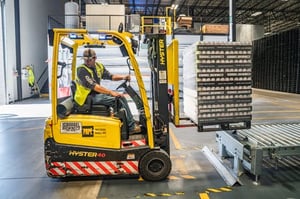
You might have seen a couple blog posts about Warehouse Management System (WMS). If you haven’t seen the posts already, please check out the blog posts: 4 Things to Consider Before You Invest in a Warehouse Management System (WMS) & Evolution of NetSuite & Warehouse Management.
In this post I want to introduce WAERlinx - Advanced Warehouse Management For NetSuite which is being used by many businesses and I have received numerous feedback to post about things to know for the first time user.
- Supply Chain Hub

Supply Chain Hub is the overview of your Warehouse(s) and its locations. This is my favorite feature because you can design and customize your location(s) and user setting. It provides the location and the inventory within the location. You can add location, remove location, and adjust the location; you can drill down to see a lot more details of the inventory. You can set your pick walk sequence, putaway walk sequence, lock a certain item to be placed, merge items, and location count scheduling. Not only you can move inventory from one location to another, you can also add/remove inventory from the Supply Chain. The neat feature in Supply Chain Hub is that you can set different printers at the location level, warehouse level, or user level.

- Work Hub

Work hub has features to manage task such as Receiving, Picking, Packing, Shipping, Manufacturing, and Cycle count. Work hub controls the user task and manages the task/ order status. The functionality might be different per businesses as WAERlinx offers flexibility for each unique business. The most common use for the item hub is “Pick Release”. “Pick Release” allows you to assign pick tasks in different pick methods, dispatch bays and filters based on your requirement.

- Item Hub

Item hub is the overview of your item(s). The supply chain hub is a feature to adjust your location setting and adjust from the location point of view while the Item hub is to adjust your item setting from the item point of view. It has features to set rules, unit of measure, the status of inventory and history of the item. Putaway rules, Item Count Scheduling, and Movements of the item can be managed as well. It gives you the full detail of the history and each movement from the receiving or write on.


- Console


Console provides many reports and KPIs in the system. The drop down will show all reports and KPIs. I will review the most frequently used ones in this post.
a. Transaction History Report – Transaction History Report is the one used most frequently. You should use this report to view detailed transaction history against predefined criteria. These criteria include date ranges, movement types, locations and traceable information. Please note that multiple movement types can be selected by holding down the control key.

b. Inventory Report – You can run this report at any level in your supply chain hierarchy to see the inventory in the container.

c. Dashboard and KPI – There are eight standard dashboard/ KPI to measure the productivity and activity in different areas.

Want to learn more about WAERlinx support, or get guided support in U.S.? Contact Concentrus today to discuss about the support package.




